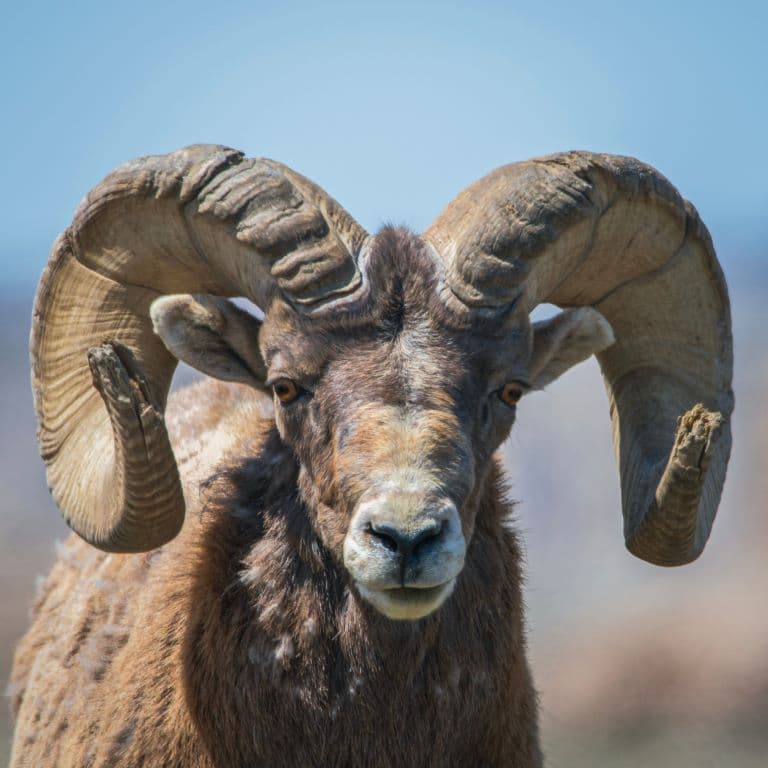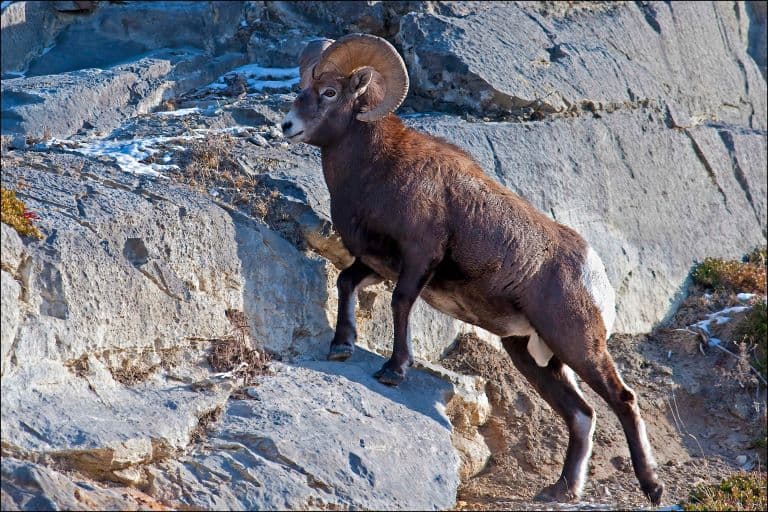Bighorn Sheep Profile
Sheep aren’t known for their wits, but that’s not really their fault; the ones we’re most familiar with have been bred to be slow and docile, burger-shaped and incestuous. Wild sheep are an entirely different animal.
Bighorns are a perfect example of what our disenfranchised livestock may once have been. They are tough, smart, fast and exceedingly good-looking.
They are also adorned with immense appendages: just the kind one’s maternal parent might be inclined to covet.

Bighorn Sheep Facts Overview
| Habitat: | Cooler mountainous regions and hot desert regions |
| Location: | US and Canada |
| Lifespan: | Max 19 years |
| Size: | 180 cm (70.87 in) |
| Weight: | 143 kg (315 lb) |
| Colour: | Grey to brown |
| Diet: | Grasses, sedges, and forbs, |
| Predators: | Black bears, grizzly bears, wolves, mountain lions, lynx |
| Top Speed: | 48 km/h (30mph) |
| No. of Species: | 1 |
| Conservation Status: | Least Concern |
Bighorn sheep are appropriately named for the epic, coiled protrusions the males present with. These are not just for show, they’re also fantastic at fighting or breaking down the door of a medieval fortress.
The former occurs as a routine part of the mating process, and the immense forces produced are countered by a clever little set of adaptations that protect the ram’s brain.
For their size, they’re remarkably agile and well suited for both high, craggy mountain terrain and hot desert. Once ubiquitous across the continent, they’ve dwindled in number but are now stable and not threatened.
Interesting Bighorn Sheep Facts
1. They’re horny
Both females and males have horns, but it is the male bighorn sheep who really live up to their names. They have incredible horns and would be an honourable association for the Aries Zodiac sign if it weren’t all such imaginary nonsense.
These horns come out of the side of the sheep’s head and curl back and around, coming full circle in some, and even completing a second rotation in particularly horny individuals. They can be up to 76cm long, and weigh up to 22 kg (50 lb)!
And because girth is equally, if not more important, the circumference at the base can be almost 40cm.
These horns are roughly the weight of all the other bones in the ram’s body combined, so it must be exhausting to carry them around all day. 1

2. They clash heads
These epic horns are not just trophies, either. Certainly, carrying 22kg on your head for much of your adult life does suggest a certain level of strength, and no doubt females are inclined to reproduce with such a demonstrably enduring individual, but when a rival male questions this fitness, the horns are used to full effect.
Horn size is a symbol of rank, but also the tool with which to back it up. Rams collide heads at up to 20mph,
These clashes come at the culmination of a choreographed duel-like routine, in which they size each other up, take positions and begin.
The horns can take considerable damage during these bouts, but their brains, somehow, don’t.
A bighorn ram might not be winning any Scrabble tournaments after a clash like this, but that has more to do with their lack of interest in the sport than the forces they suffer. In fact, enlarged pockets, or sinuses in the skull help distribute the forces away from the brain and reduce damage.

3. They’re surprisingly good climbers
A lack of thumbs doesn’t preclude these sheep from feats of agility, though. While perhaps not as magic as mountain goats, these animals can hold their own in the mountains very well.
They can walk along ledges only 5cm across, jump clear six-meter cracks in the ground in a single leap and run up a mountain at 25 km/h. On flat ground they’re remarkably fast, too, having been clocked at 48km/h.
And even the most well-endowed male is a competent swimmer, making these some of the best all-terrain burger animals on Earth.
Most populations move seasonally, from larger upland areas in the summer to sheltered valleys during the winter; the only terrain they struggle with is deep snow. 2

4. They’re hot and cold
With all this physical talent, it’s no wonder they can live almost anywhere. There are three agreed-upon subspecies, at least two of which have occupied almost opposite habitats.
The Rocky Mountains and Sierra Nevada bighorn sheep are cold weather specialists, occupying the high-altitude, cooler regions of the US and Canada.
But their cousins further South are absolutely at home in the deserts of the Southwest and Mexico.
5. They have excellent eyesight
These sheep are not without their share of enemies. Most large carnivores will have a go at one, so vigilance is critical to their survival.
Bighorns are very alert, and sport surprisingly good eyesight – likely an adaptation that serves them well when running across unpredictable terrain.
They are said to pay attention to what other animals are doing, even up to a mile away. They don’t talk much, but they do take a lot in. 3
6. They were prevalent
The species was once a lot more widespread, numbering up to 2 million by the beginning of the 19th century.
By the late 1800s, livestock had significantly replaced hunting as a destructive force on the community, and domestic sheep brought with them domestic sheep diseases, which reduced the Bighorn numbers further.
These problems are reducing, and the bighorn population has stabilised, but fewer than 70,000 animals remain today, a reduction of up to 96.5%.
Habitat loss and fragmentation remain a significant problem. 4
7. Legends
Having once been widespread, they’ve spawned some legends in their time. Native peoples such as the Apsáalooke deeply admired these animals, and their artwork attests to this.
One legend from the region speaks of a boy attacked by a man who was possessed by spirits. The boy is then rescued by a bighorn ram and granted the sheep’s power. He acquires wisdom, sure-footedness, great vision and hearing, superhuman strength and a strong heart.
In return, the ram told the boy that the mountains and river should forever be called Bighorn, and if is ever changed, the tribe would lose its land. 5
Bighorn Sheep Fact-File Summary
Scientific Classification
| Kingdom: | Animalia |
| Phylum: | Chordata |
| Class: | Mammalia |
| Order: | Artiodactyla |
| Family: | Bovidae |
| Genus: | Ovis |
| Species: | Canadensis |
Fact Sources & References
- (2018), “THE CROW LEGEND: HOW THE BIGHORN RIVER GOT ITS NAME”, Forrester’s Bighorn River Resort.
- WildlifeOnVideo (2023), “Bighorn Sheep Quickly Calculate Mountain Climbing Routes”, YouTube.
- Author Name (Year), “The Bighorn Sheep: Majestic and Memorable”, Nature Canada.
- “Bighorn Sheep”, IUCN Red List.
- Author Name (Year), “THE CROW LEGEND: HOW THE BIGHORN RIVER GOT ITS NAME”, Forrester’s Bighorn River Resort.
